Page 10 of 306
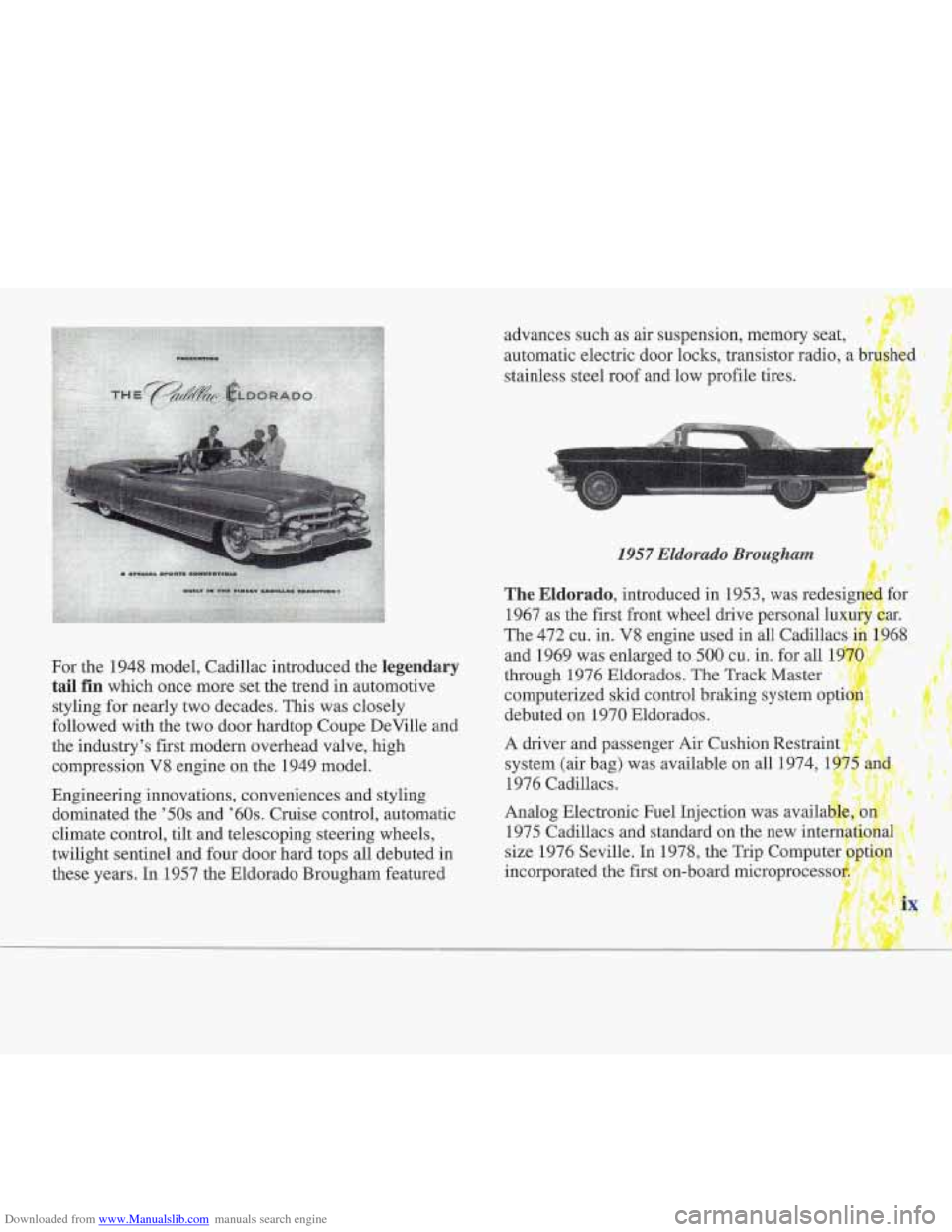
Downloaded from www.Manualslib.com manuals search engine advances such as air suspension, memory seat, '
automatic electric door locks, transistor radio, a b;
stainless steel roof and low profile tires.
I
~ ....
For the 1948 model, Cadillac introduced the legendary
tail
fin which once more set the trend in automotive
styling for nearly
two decades. This was closely
followed with the two door hardtop Coupe DeVille and
the industry's first modern overhead valve, high compression V8 engine on the 1949 model.
Engineering innovations, conveniences and styling dominated the
'50s and '60s. Cruise control, automatic
climate control, tilt and telescoping steering wheels,
twilight sentinel and four door hard tops all debuted in
these years. In 1957 the Eldorado Brougham featured
1957 Eklorado Brougham
The Eldorado, introduced in 1953, was
1967 as the first front wheel drive perso
The 472 cu. in. V8 engine used in all Cadilla
and 1969 was enlarged to
500 cu. in. for all 1
through 1976 Eldorados. The Track Ma
computerized skid control braking
sys
debuted on 1970 Eldorados.
A driver and passenger Air Cushion Restraint
system (air bag) was available on all 1974,
1
1976 Cadillacs.
Analog Electronic
Fuel Injection was
1975 Cadillacs and standard on the ne
Page 93 of 306
Downloaded from www.Manualslib.com manuals search engine Windshield Washer
At the top of the turn signal lever is a paddle with the
word
PUSH on it. To spray washer fluid on the
windshield, press the paddle. The washer will continue
to spray until you release the paddle. The wipers will
clear the window and wipe a few more times before
stopping
or returning to the previous setting.
Cruise Control
_In freezing weather, don’t use your washer until
the windshield is warmed. Otherwise the washer
fluid can form ice on the windshield, blocking
your vision.
With cruise control, you can
maintain a speed
of about
25 mph (40 km/h) or more
without keeping your foot
on the accelerator. This can
really help on long trips. Cruise control does not
work at speeds below about
25 mph (40 km/h).
When you apply your brakes, the cruise control shuts off.
Page 94 of 306
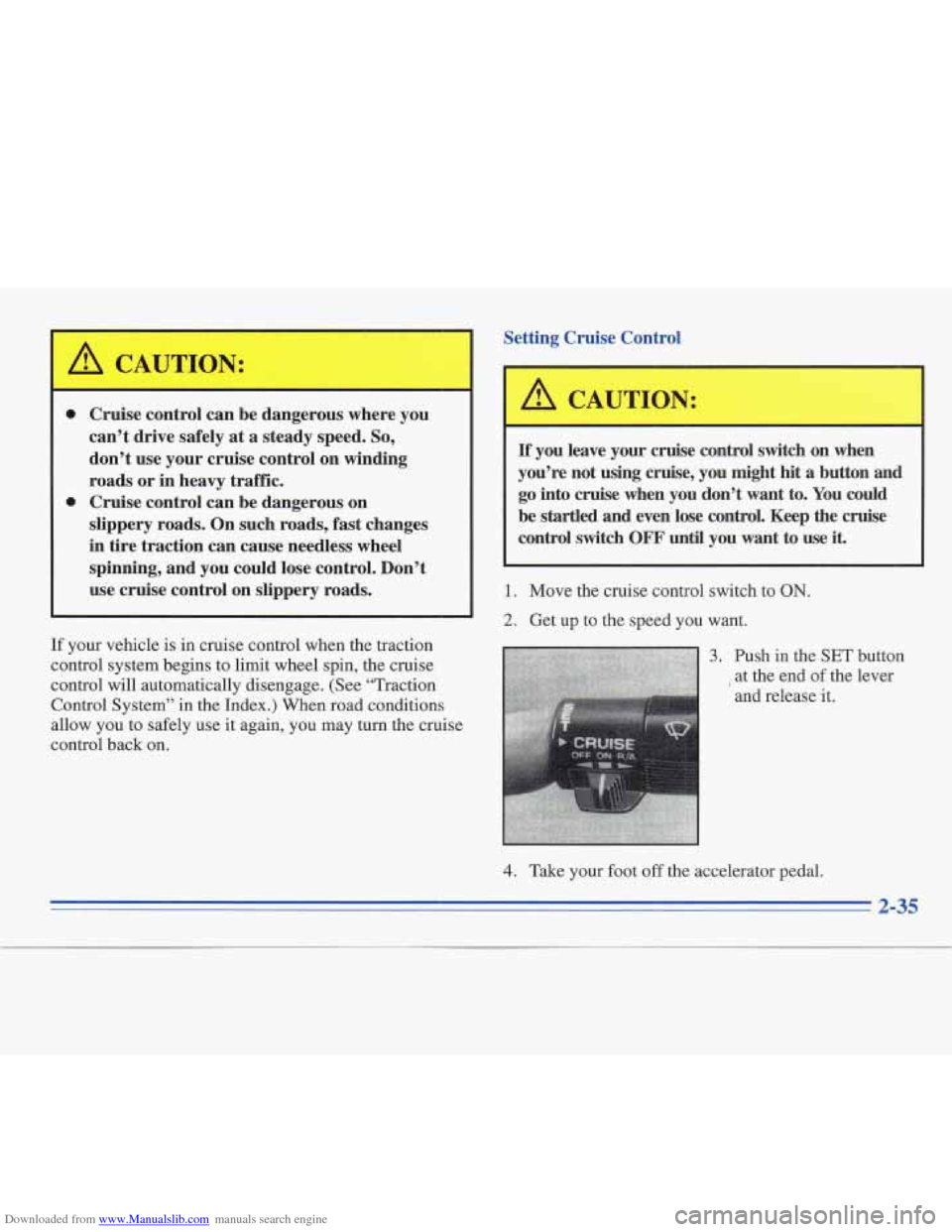
Downloaded from www.Manualslib.com manuals search engine Setting Cruise Control
0
0
Cruise control can be dangerous where you
can’t drive safely
at a steady speed. So,
don’t use your cruise control on winding
roads
or in heavy traffic.
Cruise control can be dangerous on
slippery roads. On such roads, fast changes
in tire traction can cause needless wheel
spinning, and you could lose control. Don’t
use cruise control on slippery roads.
L
If your vehicle is in cruise control when the traction
control system begins to limit wheel spin, the cruise
control will automatically disengage. (See “Traction
Control System” in the Index.) When road conditions
allow you to safely use it again.
vou may turn the cruise
control back on.
If’ you leave your cruise control switch on when
you’re not
using cruise, you might hit a button and
go into cruise when you don’t want to. You could
be startled and even lose control. Keep the cruise
control switch
OFF until you want to use it.
1. Move the cruise control switch to ON.
2. Get up to the speed you want.
3. Push in the SET button
I at the end of the lever
and release it. I
4. Take your foot off the accelerator pedal.
2-35
Page 95 of 306
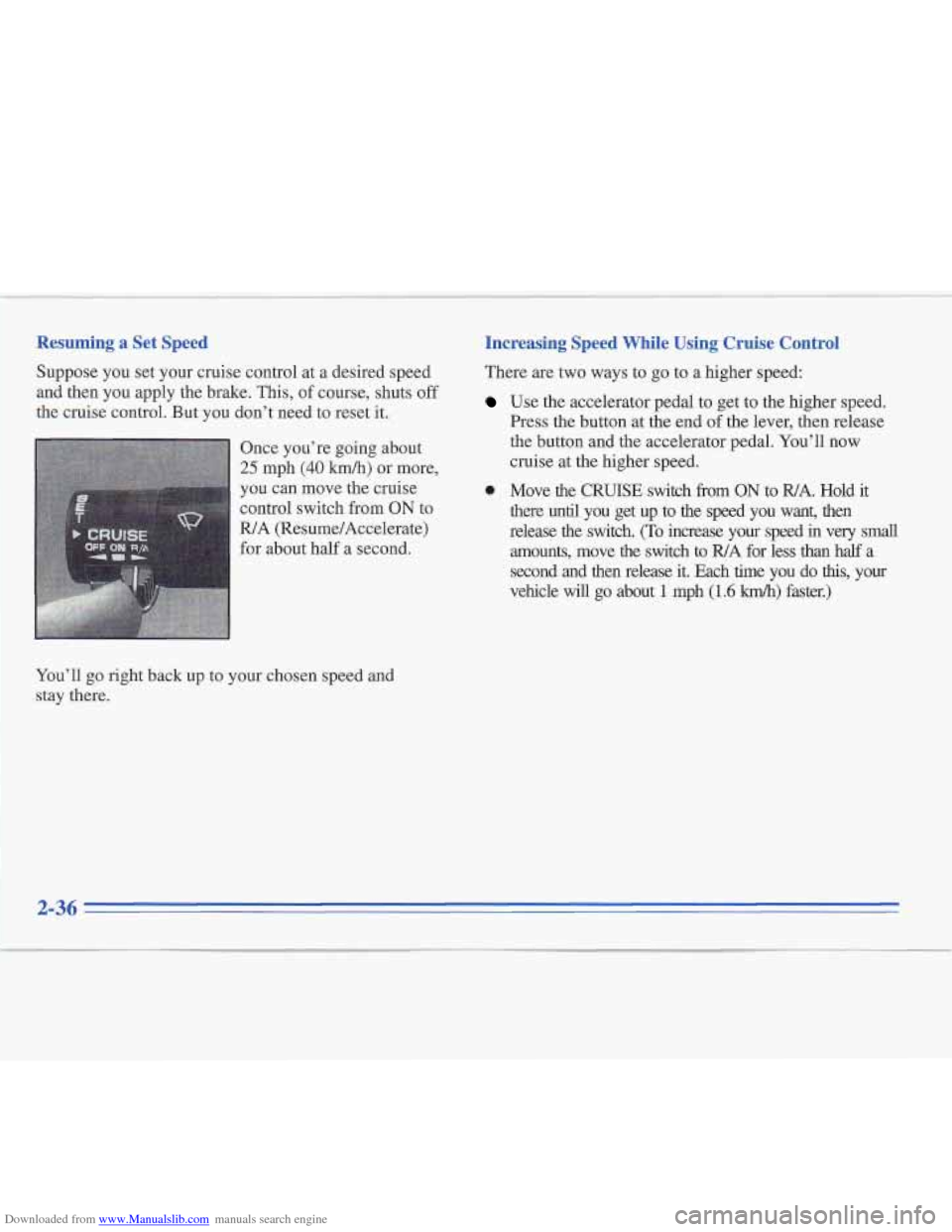
Downloaded from www.Manualslib.com manuals search engine Resuming a Set Speed
Suppose you set your cruise control at a desired speed
and then you apply the brake.
This, of course, shuts off
the cruise control. But you don’t need to reset it.
Once you’re going about
25 mph (40 Wh) or more,
you can move the cruise
control switch from
ON to
You’ll go right back up to your chosen speed and
stay there.
Increasing Speed While Using Cruise Control
There are two ways to go to a higher speed:
Use the accelerator pedal to get to the higher speed.
Press the button at the end of the lever, then release
the button and the accelerator pedal. You’ll now
cruise at the higher speed.
0 Move the CRUISE switch from ON to WA. Hold it
there until you get up to
the speed you wanc then
release
the switch. (To increase your speed in very small
amounts, move the switch to WA for less than half a
second and then release it. Each time you do
this, your
vehicle will
go about 1 mph (1.6 km/h) faster.)
2-36
Page 96 of 306
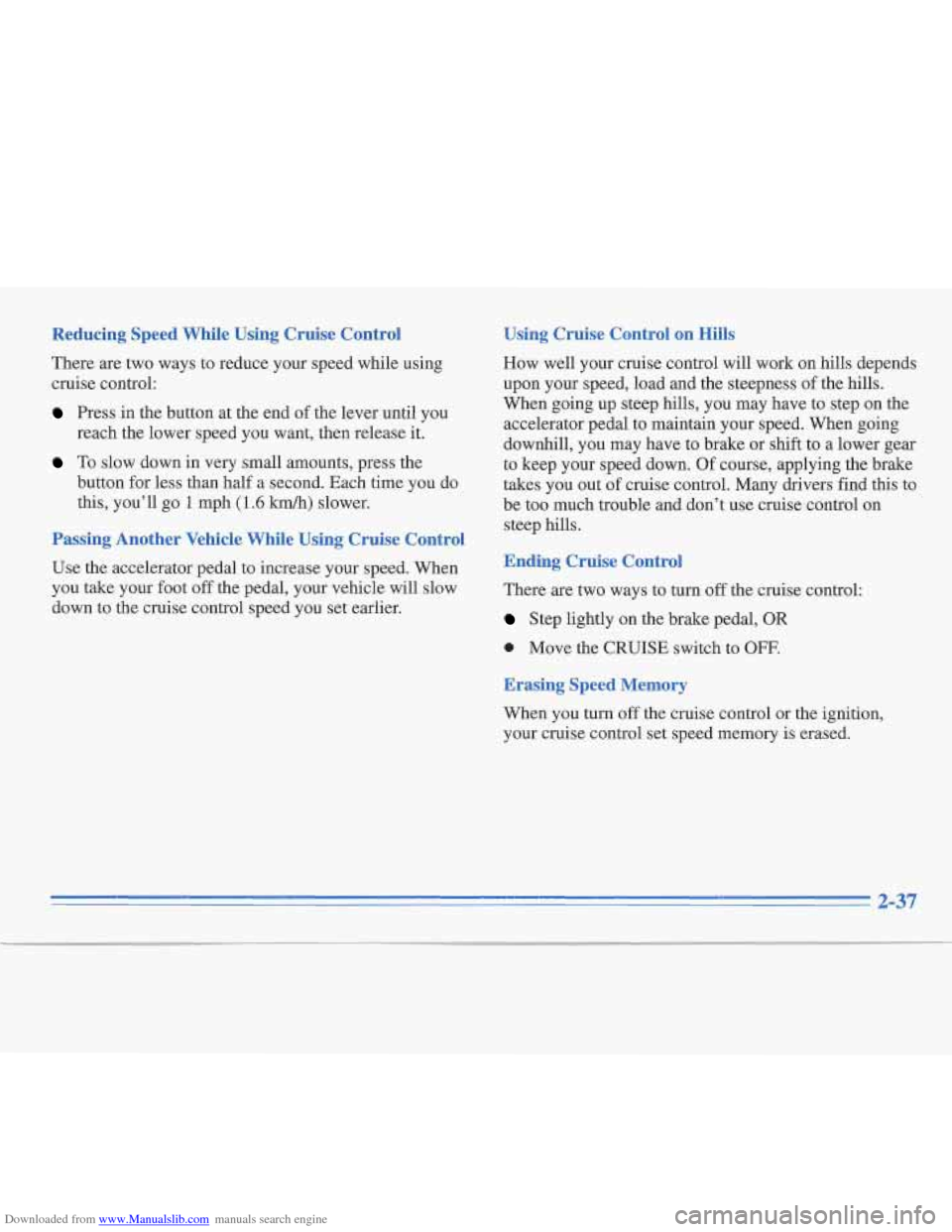
Downloaded from www.Manualslib.com manuals search engine Reducing Speed While Using Cruise Control
There are two ways to reduce your speed while using
cruise control:
Press in the button at the end of the lever until you
reach the lower speed you want, then release it.
To slow down in very small amounts, press the
button for less than
half a second. Each time you do
this, you’ll go
1 mph (1.6 km/h) slower.
Passing Another Vehicle While Using Cruise Control
Use the accelerator pedal to increase your speed. When
you take your foot
off the pedal, your vehicle will slow
down to the cruise control speed you set earlier.
Using Cruise Control on Hills
How well your cruise control will work on hills depends
upon your speed, load and the steepness of the hills.
When going up steep hills, you may have to step on the
accelerator pedal to maintain your speed. When going
downhill, you may have to brake or shift to a lower gear
to keep your speed down. Of course, applying the brake
takes you out of cruise control. Many drivers find this to
be too much trouble and don’t use cruise control on
steep hills.
Ending Cruise Control
There are two ways to turn off the cruise control:
Step lightly on the brake pedal, OR
0 Move the CRUISE switch to OFF.
Erasing Speed Memory
When you turn off the cruise control or the ignition,
your cruise control set speed memory is erased.
2-37
Page 111 of 306
Downloaded from www.Manualslib.com manuals search engine Instrument Panel CIuster
TRACTION LEVEL
ENGAGED RIDE
TRUNK SECURITY
AJAR SYSTEM
PASS
KEY FAULT TEMP -k -
957; FASTEN
PRESSURE BELTS
SERVICE ENGINE
tziTJK (e) SOON
CRUISE TRACTION
ENGAGED CONTROL
UNLEADED FUEL ONLY
ELOW @ F
irllilllirllilrli
[ P RNOD21 1
FLUID LOW OIL
WASHER
CHANGE
El
(0)
CHARGE
BRAKE
I 3AG AIR
LOW )IL
LEVEL COOLANT LO w
DOOR AJAR BRAKE TO SHIFT
The instrument panel is designed to let
you know at a glance how your Cadillac is running. You’ll know how fast you’re
going, how much fuel you’re using, and
many of other things you’ll need to know to drive safely and economically.
Page 125 of 306
Downloaded from www.Manualslib.com manuals search engine Cruise Engaged Light
This light will come on
when your cruise control is
set to a selected speed.
CRUISE
ENGAGED
Washer Fluid Low Light
WASHER
FLUID LOW
This
bulb light comes
on as a
check when you start
your engine.
If this light
comes on when your
washers
are turned on,
you're low on washer fluid.
Add fluid. See "Windshield
Washer
Fluid" in the Index.
Driving without washer fluid can be dangerous.
A bad
mud splash can block your vision.
You could hit
another vehicle or go off the road. Check your washer
fluid level often.
Page 153 of 306
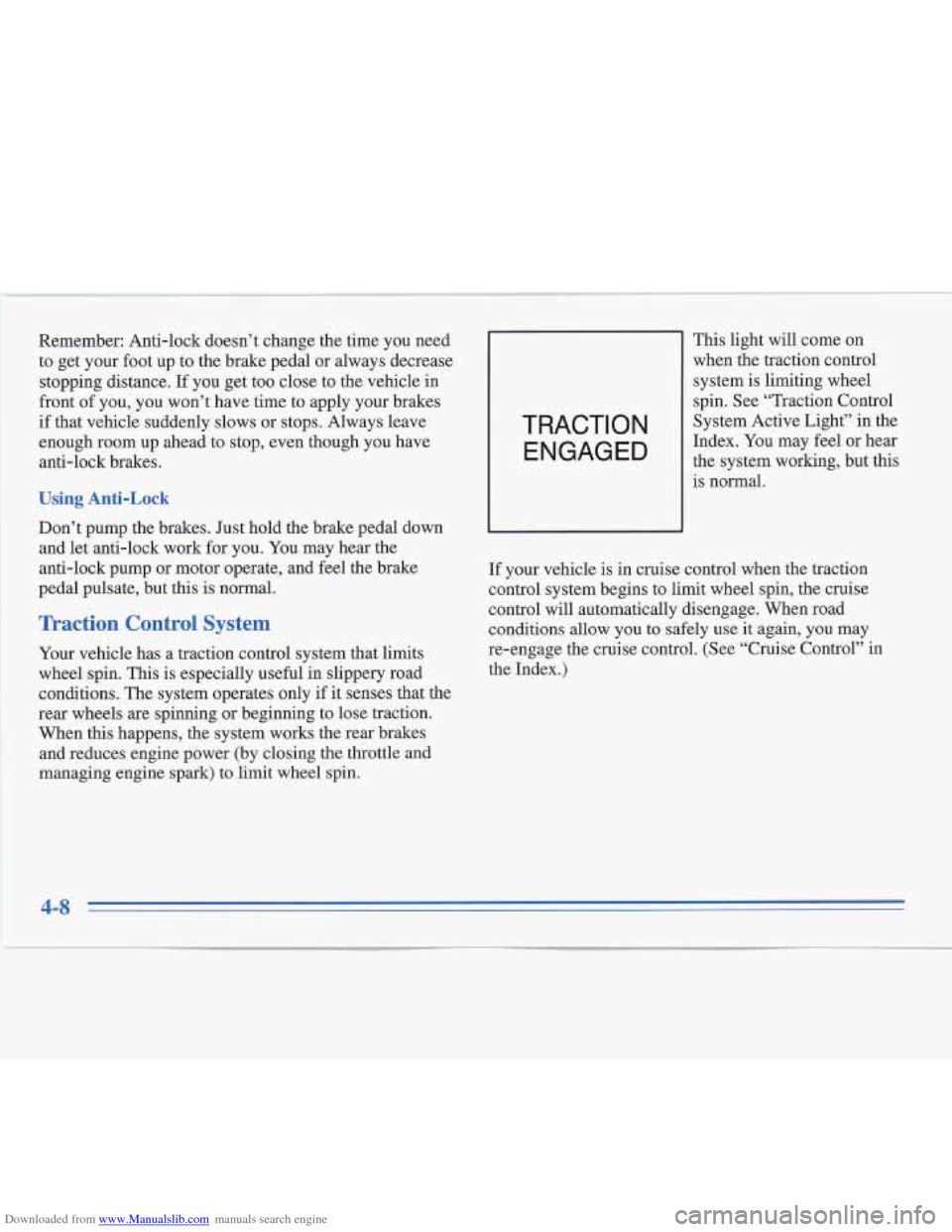
Downloaded from www.Manualslib.com manuals search engine Remember: Anti-lock doesn’t change the time you need
to get your foot up to the brake pedal or always decrease
stopping distance. If you get too close to the vehicle
in
front of you, you won’t have time to apply your brakes
if that vehicle suddenly slows or stops. Always leave
enough room up ahead to stop, even though you have
anti-lock brakes.
Using Anti-Lock
Don’t pump the brakes. Just hold the brake pedal down and let anti-lock work for you. You may hear the
anti-lock pump or motor operate, and feel the brake
pedal pulsate, but this is normal.
Traction Control System
Your vehicle has a traction control system that limits
wheel spin. This is especially useful in slippery road
conditions. The system operates only if it senses that the
rear wheels
are spinning or beginning to lose traction.
When this happens, the system works the rear brakes
and reduces engine power (by closing the throttle and
managing engine spark)
to limit wheel spin.
1
This light will come on
when the traction control
TRACTION
ENGAGED
system is limiting wheel
spin. See “Traction Control
System Active Light” in the
Index. You may feel or hear
the system working, but this
is normal.
If your vehicle is in cruise control when the traction
control system begins to limit wheel spin, the cruise
control will automatically disengage. When road
conditions allow you to safely
use it again, you may
re-engage the cruise control. (See “Cruise Control” in
,,,*
the l[nrSa.x.)
4-8